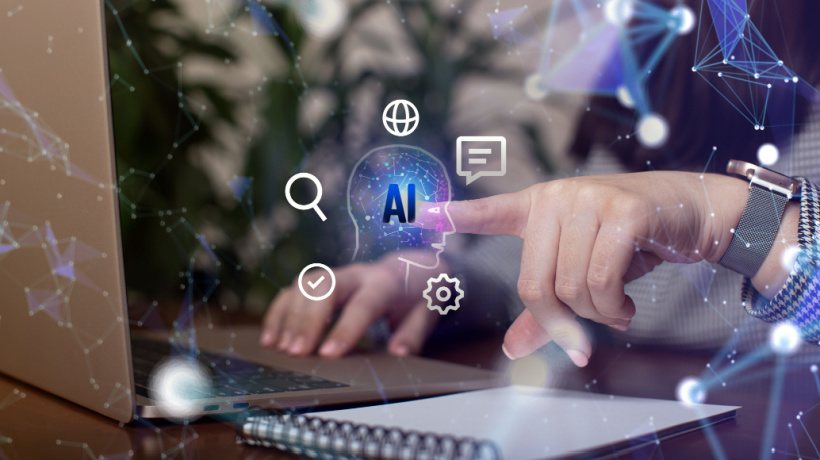AI-Driven Performance Support
Welcome to part six of our progressive series examining the influential dynamic of Artificial Intelligence (AI) within the realm of Learning and Development (L&D). As we continue on our intellectual journey, we find ourselves drawing parallels with the enlightening metaphor presented by Steve Jobs in his iconic video, wherein he eloquently described computers as a "bicycle for our minds", boosting our cognitive capabilities in groundbreaking ways.
This metaphor resonates deeply when applied to the interplay of AI and L&D, and in this sixth installment, our discourse takes an intriguing turn towards the concept of "AI-driven performance support." As we excavate the layers of this notion, we discover that it isn't solely about learning as an isolated objective. Rather, it is about the seamless fusion of learning with our work, catalyzing both personal and team development, while simultaneously bolstering organizational performance.
The Evolution Of Performance Support: Preceding The Advent Of AI-Driven Personal Assistants
The inception of performance support in corporate learning dates to the 1970s, pioneered by Rummler and Gilbert, who highlighted the need for contextual, immediate guidance for effective employee performance (Gilbert and Rummler, 1970). Gery, in the 1990s, popularized the term "performance support," and introduced the concept of Electronic Performance Support Systems (EPSS), providing on-demand, job-specific learning resources. While Gery is often credited for the modern application of performance support, her work was influenced by Rummler and Gilbert's foundational theories.
One of the superstitions in the training business is that skills have no value unless they are fixed in our memories.
- Gilbert and Rummler.
Performance support is a valuable approach to providing guidance and support to employees in the workplace. It aims to minimize the need for traditional training hours that may not always be effective. By providing employees with the knowledge and information they need to perform their jobs effectively, performance support can help them acquire skills faster and reduce the occurrence of mistakes.
Traditionally, training has been the go-to solution for organizations to equip their employees with the skills and knowledge required for their roles. However, training can be time-consuming and costly, and may not always result in effective learning outcomes. Gery's approach emphasized the substitution of training with performance support, which proved to be a brilliant idea. The concept suggests that by offering on-the-job support and guidance, employees can enhance their productivity and performance.
Key proponents of performance support are Rossett and Schafer, who described performance support as a repository for information, processes, and perspectives that guide planning in action. They emphasized that performance support should be customized for individuals and accessible 24/7/365, providing usable and relevant information whenever needed. It can be used as preparation or support during task execution, ensuring that end users perform their tasks without mistakes or errors (Rossett and Schafer, 2007).
Also influential in the evolution of performance support are Mosher and Gottfredson, who introduced the concept of "five moments of need." Employees have five distinct moments when they require support: learning for the first time, learning more, applying what they have learned, solving problems, and changing what they do based on new information. Performance support aims to address these moments effectively, providing the necessary resources and guidance (Mosher and Gottfredson, 2011).
Performance support is recognized by L&D professionals as a significant strategy for fostering "on-the-job" learning, effectively serving as a cornerstone for the "70" in the 70:20:10 reference model (Arets, et al., 2015). However, this understanding, while widely adopted, represents a departure from the model's original design. The authors of the 70:20:10 reference model never intended for the model to be interpreted as three separate boxes of learning. Instead, they conceived the model elements as inherently intertwined, emphasizing the continuum and interplay of learning, rather than distinct and segregated categories. Thus, while performance support is vital, its role should be seen as part of an integrated approach to learning, rather than a standalone solution.
Performance support offers several advantages in addition to traditional training. Firstly, it allows employees to access information and guidance in real time, enabling them to address challenges and questions as they arise. This immediate support can significantly reduce the time spent searching for information or waiting for assistance. Secondly, performance support can improve overall productivity and reduce errors. By providing employees with the right information at the right time, one can ensure that they can perform tasks more efficiently and effectively. This can lead to increased job satisfaction, as employees feel more confident and competent in their roles.
Limitations Of Performance Support
While performance support boasts several advantages, it is not without its limitations. Traditionally, performance support systems were hampered by technical constraints. Despite having a vast repository of knowledge and resources, the right information at the right time often eluded employees due to the lack of user-friendly interfaces and real-time support mechanisms.
This limitation has been a significant barrier for many organizations and teams in effectively leveraging performance support. Despite seeing its potential value, the inability to implement a seamless, intuitive, and timely performance support system has led to hesitation in its adoption.
Unleashing Potential: Superpowered Performance Support Through AI-Driven Personal Assistants
With the advent of AI-driven personal assistants, we are on the brink of a revolution that promises to radically enhance performance support and unlock unprecedented possibilities. Traditional performance support is relatively passive, primarily offering step-by-step guidance for task completion (Rossett and Schafer, 2007). However, the new generation of AI-driven personal assistants, inspired by advancements in AI, extends beyond these constraints by providing active and proactive support to learners.
This superpowered performance support does not merely guide; it anticipates, recommends, automates, and learns alongside the user. Table 1 encapsulates various opportunities presented by AI in enhancing performance support systems, supplemented by a brief description, practical examples, opportunities, and potential limitations.

Table 1: Superpowered performance support by AI-driven personal assistants
AI and large language models offer unique avenues for L&D to support learning in the flow of work. Performance support systems are integral to just-in-time learning, providing immediate, contextual assistance in performing tasks (Gery, 1991). AI-powered performance support systems, with their ability to provide real-time, context-aware assistance and feedback, can significantly enhance this aspect of learning in the flow of work.
For instance, large language models can analyze the task at hand and provide immediate, personalized assistance. This integration of AI and performance support systems in the workflow allows for a seamless, on-demand learning experience (Radford, et al., 2020). Let's envision an example to bring this to life. Take John, a field engineer troubleshooting an intricate problem with a machine component. With traditional performance support, John would have to search through lengthy manuals or PDFs, potentially taking time away from more pressing tasks. In contrast, his AI-driven personal assistant, which could be a refined system like an evolved ChatGPT, can provide instantaneous, context-specific guidance, obliterating the need for exhaustive searches. This AI assistant can talk John through the process, step by step, while he keeps his hands on the task, and even offer automated troubleshooting scenarios based on similar cases in the past.
AI Versus L&D Professionals And SMEs
In comparing AI with L&D professionals and Subject Matter Experts (SMEs), one must consider the unique capabilities of each. L&D professionals and SMEs bring in-depth knowledge, experience, and a human touch to designing, developing, and implementing performance support systems. They can provide nuanced understanding, critical thinking, and judgment, which is vital for designing and developing performance support. However, when it comes to processing speed, adaptability, and scalability, AI has a distinct advantage.
- Speed and adaptability
AI can analyze large datasets, generate insights, and adapt its responses faster than human counterparts. For instance, AI-driven performance support systems can provide real-time support based on context and learner behavior, a task that would be time-consuming and potentially impractical for L&D professionals or SMEs. - Scalability
AI-driven performance support systems can be scaled to accommodate numerous users simultaneously without compromising the quality of support, something which is significantly more challenging and resource-intensive for L&D professionals and SMEs. - Consistency and availability
AI-driven performance support systems can provide consistent support around the clock, unlike human experts who may face limitations due to time constraints and cognitive load. - Personalization
AI-driven performance support systems can deliver personalized learning experiences by analyzing individual learning behaviors and adjusting support accordingly, a feat difficult to achieve by human experts, particularly with many workers/learners.
The Business Case For AI-Powered Performance Support
The advent of AI-powered performance support systems has brought transformative potential, offering viable solutions to traditional problems such as unnecessary training and costly errors. Performance support systems are increasingly shaping the landscape when it comes to supporting and empowering performance-based learning in the flow of work. The compelling business case for performance support systems hinges upon two primary tenets: the minimization of unnecessary training, and the reduction of errors.
Minimizing Unnecessary Training
AI-powered performance support systems offer an alternative to the traditional training paradigm, shifting the focus from structured, generalized training modules to targeted, on-demand, and context-specific guidance. This shift aligns with Rummler and Gilbert's proposition in their seminal 1970 Praxis report, advocating guidance as preferable to unnecessary training.
Training, especially when unnecessary or irrelevant, can result in wasted resources, both in terms of time and money. On the other hand, AI-powered performance support systems offer real-time, relevant support, minimizing the need for irrelevant or redundant training. This approach not only saves training costs, but also enhances productivity as employees can learn and adapt in the flow of work without interruption (Arets, et al., 2015).
The term "unnecessary training" specifically refers to redundant or irrelevant training beyond the requisite level needed for competency. It is not intended to dismiss or undervalue the significance of the initial and ongoing training needed to maintain and upgrade competencies in response to changing job requirements or technological advancements. Therefore, the notion of avoiding unnecessary training should be seen in the context of optimizing resource utilization and enhancing productivity after ensuring a basic level of competency in the workforce. It does not undermine the importance of foundational training and continued performance-based learning in the flow of work in building and maintaining a competent workforce.
Reducing Errors
Apart from minimizing unnecessary training, AI-powered performance support systems also offer the potential to reduce costly errors. Through predictive analysis and real-time feedback, AI can help identify potential mistakes before they occur, facilitating proactive error prevention. AI's ability to learn from past incidents and update its recommendations accordingly enhances its preventive capabilities over time. This feature can prove invaluable in high-stakes environments where errors can lead to significant financial or reputational damage, thereby presenting a compelling business case for AI-powered performance support systems (Shortliffe and Sepúlveda, 2018).
Conclusion
While the expertise and human touch provided by L&D professionals and SMEs are undeniably crucial in the development of performance support systems, the speed, adaptability, scalability, and personalization offered by AI provides a compelling argument for its integration. Therefore, rather than viewing AI as a replacement for human input, it should be seen as a powerful tool that can support L&D professionals and SMEs, enhancing the overall effectiveness of performance support systems.
AI-powered performance support systems offer a strong business case by minimizing unnecessary training and reducing costly errors. The financial and productivity gains from these two factors alone make a compelling argument for the integration of AI in L&D and business strategies. Moreover, the advantages extend beyond cost savings, leading to increased productivity, enhanced learning in the flow of work experiences, and proactive risk management.
Up Next: Unpacking L&D's Role In The AI Era
As we reach the end of our exploration of AI’s potential to amplify performance, an intriguing question arises: how does AI intersect with the contemporary reality of performance augmentation by AI? Hold on to that curiosity as we step into the next article of our series. We will be diving into the compelling world of "AI-driven augmentation" with AI as our steadfast ally. What role does AI play, with performance augmentation as an integral part of our work routine? How can L&D professionals leverage AI during working and learning?
As you continue exploring the fascinating world of AI and its potential to revolutionize Learning and Development, we invite you to delve deeper with us. Visit our website Partners in AI for more in-depth information and insights, and the opportunities that AI brings to the corporate learning sphere.
The article series titled "Is AI The Bicycle Of The Mind?" serves as a prelude to my upcoming book, Value-Based Learning, offering a sneak peek into the insightful content the book will feature. Please note that all rights to the content in these articles and the upcoming book are reserved. Unauthorized use, reproduction, or distribution of this material without explicit permission is strictly prohibited. For more information and updates about the book, please visit: Value-Based Learning.
The author of this work holds intellectual property rights, and this content cannot be reproduced or repurposed without express written permission.
References
- Agrawal, A., J. Gans, and A. Goldfarb. 2018. Prediction Machines: The Simple Economics of Artificial Intelligence. Cambridge, MA: Harvard Business Press.
- Arets, J., C. Jennings, and V. Heijnen. 2015. 70:20:10 towards 100% performance. Maastricht and London: Sutler.
- Gery, G. 1991. Electronic performance support systems: How and why to remake the workplace through the strategic application of technology. Boston: Weingarten Publications.
- Gilbert, T, and G. Rummler (owners of Praxis Corporation and probable authors). 1970. "Guidance: The Short Way Home." Praxis Reports. Praxis Corporation, New York. Accessed via EPPIC – Pursuing Performance (July 2023).
- Mosher, B., and C. Gottfredson. 2011. Innovative performance support: Strategies and practices for learning in the workflow. New York: McGraw-Hill.
- Radford, A., J. Wu, R. Child, D. Luan, D. Amodei, and I. Sutskever. 2019. Language models are unsupervised multitask learners. OpenAI Blog.
- Rossett, A., and L. Schafer. 2007. Job aids and performance support. San Francisco, CA: Pfeiffer.
- Shortliffe, E. H., amd M. J. Sepúlveda. 2018. "Clinical Decision Support in the Era of Artificial Intelligence." Journal of the American Medical Association 320 (21): 2199–200.
Image Credits
- The table within the body of the article has been created/supplied by the author.









